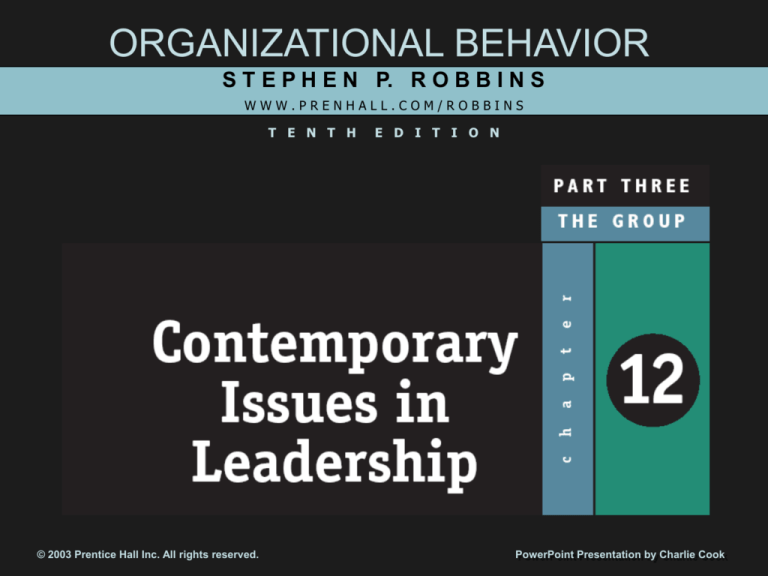
ORGANIZATIONAL BEHAVIOR
S T E P H E N P. R O B B I N S
WWW.PRENHALL.COM/ROBBINS
T E N T H
© 2003 Prentice Hall Inc. All rights reserved.
E D I T I O N
PowerPoint Presentation by Charlie Cook
OBJECTIVES
LEARNING
AFTER STUDYING THIS CHAPTER,
YOU SHOULD BE ABLE TO:
1. Identify the five dimensions of trust.
2. Define the qualities of a charismatic leader.
3. Contrast transformational with transactional
leadership.
4. Identify the skills that visionary leaders
exhibit.
5. Explain how framing influences leadership
effectiveness.
6. Identify four roles that team leaders perform.
© 2003 Prentice Hall Inc. All rights reserved.
12–2
O B J E C T I V E S (cont’d)
LEARNING
AFTER STUDYING THIS CHAPTER,
YOU SHOULD BE ABLE TO:
7. Explain the role of a mentor.
8. Describe how on-line leadership differs from
face-to-face leadership.
9. Identify when leadership may not be
necessary.
10. Explain how to find and create effective
leaders.
© 2003 Prentice Hall Inc. All rights reserved.
12–3
Trust: The Foundation of Leadership
EXHIBIT
12-1
© 2003 Prentice Hall Inc. All rights reserved.
12–4
Trust and Leadership
Leadership
TRUST
and
INTEGRITY
© 2003 Prentice Hall Inc. All rights reserved.
12–5
Three Types of Trust
© 2003 Prentice Hall Inc. All rights reserved.
12–6
Leaders as Shapers of Meaning: Framing
Issues
Leaders use framing
(selectively including
or excluding facts) to
influence how others
see and interpret
reality.
© 2003 Prentice Hall Inc. All rights reserved.
12–7
Charismatic Leadership
Key Characteristics:
1. Vision and
articulation
2. Personal risk
3. Environmental
sensitivity
4. Sensitivity to
follower needs
5. Unconventional
behavior
© 2003 Prentice Hall Inc. All rights reserved.
12–8
Key Characteristics of Charismatic Leaders
EXHIBIT
© 2003 Prentice Hall Inc. All rights reserved.
12-2
12–9
Transactional and Transformational Leadership
• Contingent Reward
• Charisma
• Management by
Exception (active)
• Inspiration
• Management by
Exception (passive)
• Intellectual Stimulation
• Individual
Consideration
• Laissez-Faire
© 2003 Prentice Hall Inc. All rights reserved.
12–10
Characteristics of Transactional Leaders
EXHIBIT
© 2003 Prentice Hall Inc. All rights reserved.
12-3a
12–11
Characteristics of Transformational Leaders
EXHIBIT
© 2003 Prentice Hall Inc. All rights reserved.
12-3b
12–12
Visionary Leadership
Qualities of a Vision:
• Inspiration that is valuecentered
• Is realizable
• Evokes superior imagery
• Well-articulated
© 2003 Prentice Hall Inc. All rights reserved.
12–13
Qualities of a Visionary Leader
• Has the ability to
explain the vision to
others.
• Uses own behavior
to express the vision.
• Is able to extend the
vision to different
leadership contexts.
© 2003 Prentice Hall Inc. All rights reserved.
12–14
Emotional Intelligence and Leadership
Effectiveness
Elements of Emotional
Intelligence:
• Self-awareness
• Self-management
• Self-motivation
• Empathy
• Social skills
© 2003 Prentice Hall Inc. All rights reserved.
12–15
Contemporary Leadership Roles: Providing
Team Leadership
Team Leadership Roles:
• Act as liaisons with
external constituencies.
• Serve as troubleshooters.
• Manage conflict.
© 2003 Prentice Hall Inc. All rights reserved.
12–16
Contemporary Leadership Roles: Mentoring
Mentoring Activities:
• Present ideas clearly
• Listen well
• Empathize
• Share experiences
• Act as role model
• Share contacts
• Provide political
guidance
© 2003 Prentice Hall Inc. All rights reserved.
12–17
Contemporary Leadership Roles:
Self-Leadership
Creating self leaders:
• Model self-leadership.
• Encourage employees to
create self-set goals.
• Encourage the use of selfrewards.
• Create positive thought
patterns.
• Create a climate of selfleadership.
• Encourage self-criticism.
© 2003 Prentice Hall Inc. All rights reserved.
12–18
Moral Leadership
Actions:
• Work to positively change the
attitudes and behaviors of
employees.
• Engage in socially constructive
behaviors.
• Do not abuse power or use
improper means to attain goals.
© 2003 Prentice Hall Inc. All rights reserved.
12–19
Leadership as an Attribution
Qualities attributed to
leaders:
• Leaders are intelligent,
outgoing, have strong
verbal skills, are aggressive,
understanding, and
industrious
• Effective leaders are
perceived as consistent and
unwavering in their
decisions.
• Effective leaders project the
appearance of being a
leader.
© 2003 Prentice Hall Inc. All rights reserved.
12–20
Substitutes and Neutralizers for Leadership
EXHIBIT
© 2003 Prentice Hall Inc. All rights reserved.
12-5
12–21
Finding and Creating Effective Leaders
Selection
– Review specific requirements for the job.
– Use tests that identify personal traits associated with
leadership, measure self-monitoring, and assess
emotional intelligence.
– Conduct personal interviews to determine candidate’s
fit with the job.
Training
– Recognize the all people are not equally trainable.
– Teach skills that are necessary for employees to
become effective leaders.
– Provide behavioral training to increase the
development potential of nascent charismatic
employees.
© 2003 Prentice Hall Inc. All rights reserved.
12–22








